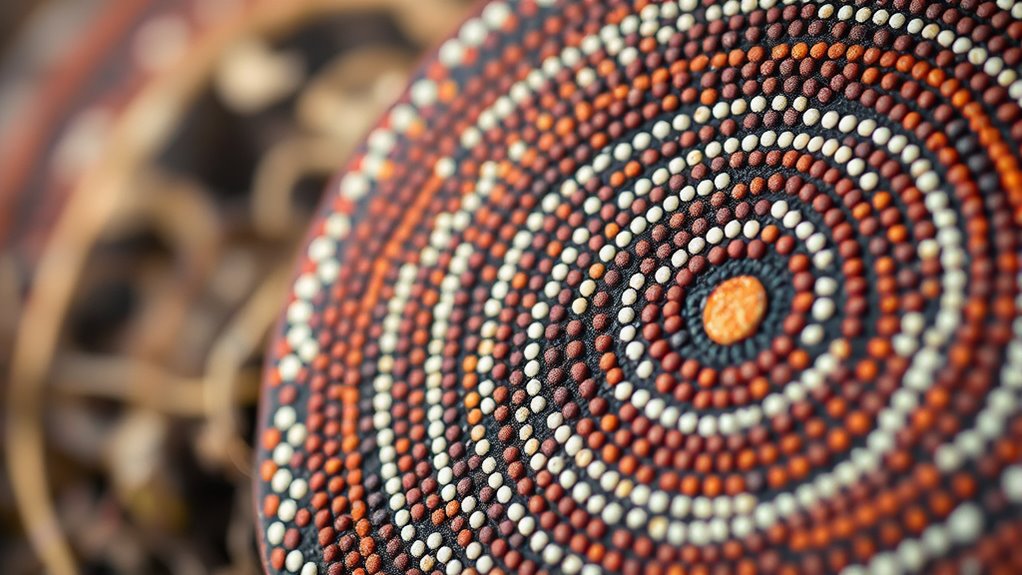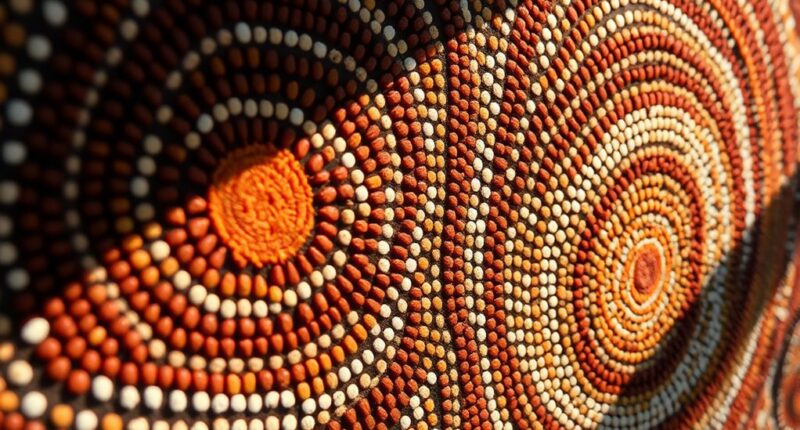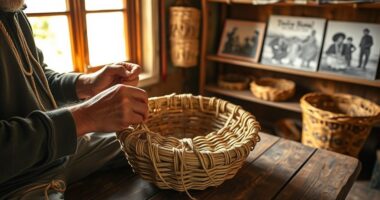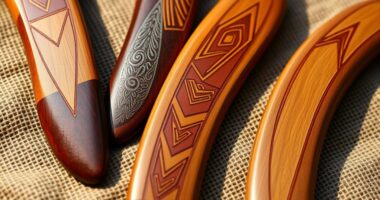Exploring Aboriginal art techniques reveals a rich cultural heritage rooted in storytelling and land connection. Dot painting, using tiny dots to create intricate patterns, symbolizes water, animals, or spiritual paths, each packed with meaning. Beyond dots, artists also use weaving, engraving, and cross-hatching to express their stories. Every technique reflects a community’s values and history. By understanding these methods, you’ll uncover the depth behind this vibrant art form—keep going to discover even more.
Key Takeaways
- Aboriginal art techniques are deeply connected to cultural stories, land, and spiritual beliefs, with dot painting being a prominent example.
- Dots in Aboriginal art symbolize elements like water, animals, and spiritual pathways, conveying cultural and symbolic meanings.
- Traditional tools such as sticks, bones, and natural pigments are used to create intricate patterns and textures.
- The process involves layering dots with precision to depict stories, landscapes, and symbolic imagery.
- Other techniques like weaving and engraving reflect the diversity and richness of Aboriginal cultural expressions.

Aboriginal art techniques are deeply rooted in tradition and serve as powerful expressions of cultural identity. When you explore these methods, you’ll find that each piece is more than just visual decoration — it’s a story, a connection to the land, and a reflection of ancestral beliefs. One of the most recognizable techniques is dot painting, which uses thousands of tiny dots to create intricate patterns and images. But beyond the aesthetic appeal, these dots often hold symbolic meanings, representing elements like water, animals, or spiritual pathways. Understanding this symbolism in art helps you appreciate the depth behind each stroke, seeing how every dot is deliberate and meaningful.
Aboriginal dot painting uses tiny dots to symbolize water, animals, and spiritual paths, reflecting cultural stories and meanings.
The tools and materials used in Aboriginal art are as significant as the imagery itself. Traditional artists often rely on natural materials found in their environment. For instance, they use brushes made from sticks, bones, or plant fibers, and they apply pigments derived from earth, charcoal, and clay. These materials are carefully prepared to produce vibrant, durable colors that last for generations. When you work with these tools and materials, you’re connecting directly to a cultural heritage that emphasizes resourcefulness and respect for the land. The way these tools are handled influences the style and texture of the artwork, giving each piece a unique character rooted in tradition.
In dot painting, the process involves more than just placing dots randomly; it’s about precision and intention. You might start with a basic outline of a design, then slowly build up layers of dots, each one adding detail and depth. The size and spacing of the dots can change to create different effects, like shading or movement, making the artwork dynamic and alive. This technique requires patience and skill, but it also invites you to slow down and connect with the story you’re telling through your art. As you learn about the tools and materials, you’ll realize that the act of creating is as important as the finished piece. Every tool used and every pigment chosen carries cultural significance, linking you to centuries of tradition. Recognizing the importance of cultural symbolism enhances your understanding and appreciation of Aboriginal art practices.
Beyond dot painting, Aboriginal artists employ a variety of techniques, such as cross-hatching, weaving, or engraving, each with its own set of tools and symbolism. These methods demonstrate the diversity and richness of Aboriginal art, reflecting different communities, stories, and spiritual beliefs. When you immerse yourself in these techniques, you gain insight into a worldview that values storytelling, community, and harmony with nature. By understanding the symbolism in art and the importance of tools and materials, you open a window into a world where every brushstroke and every dot is a meaningful act rooted in cultural heritage.
Frequently Asked Questions
How Long Does It Take to Complete a Traditional Dot Painting?
It typically takes several hours to days to complete a traditional dot painting, depending on its size and complexity. Timing considerations are essential, as detailed work demands patience and precision. You’ll need artistic patience to carefully apply each dot, ensuring the design aligns with cultural significance. Rushing can compromise the quality and meaning of your artwork, so take your time to achieve the desired effect and honor the tradition.
What Materials Are Traditionally Used in Aboriginal Art?
You use natural pigments like ochre sourced directly from the earth, along with charcoal and clay, to create traditional Aboriginal art. These materials are carefully collected through ochre sourcing, ensuring cultural significance and authenticity. The pigments are often mixed with water or binders to make paint. This process connects you to the land and its stories, preserving ancient techniques while expressing your cultural identity through vibrant, meaningful artwork.
Are There Different Styles of Aboriginal Art Across Regions?
Yes, you’ll notice regional variations in Aboriginal art styles across Australia. These differences reflect diverse cultural influences and local stories, shaping each area’s unique artistic expressions. For example, dot painting is prominent in Central Australia, while bark painting is more common in Arnhem Land. By exploring these regional styles, you gain a richer understanding of how Aboriginal communities express their identity and connection to the land through distinct artistic techniques.
Can Non-Indigenous Artists Create Authentic Aboriginal Art?
You can create aboriginal-inspired art, but ensuring cultural authenticity is essential. If you’re not Indigenous, it’s important to respect traditions and avoid cultural appropriation. Authenticity comes from understanding the cultural significance behind the symbols and styles, and collaborating with Aboriginal communities when possible. By doing so, you honor their heritage and avoid misrepresenting their art. Remember, genuine respect and knowledge make your work more meaningful and ethically sound.
How Do Aboriginal Artists Choose Their Symbols and Designs?
You should understand that Aboriginal artists choose their symbols and designs based on cultural significance and personal stories. They select symbols that reflect their connection to land, ancestors, and Dreamtime stories, ensuring each piece holds meaning. By respecting traditional practices, they incorporate these symbols thoughtfully, preserving cultural heritage. Your role is to appreciate that this symbol selection process is deeply rooted in cultural significance, making each artwork authentic and meaningful.
Conclusion
As you explore Aboriginal art techniques, you become a traveler crossing a vibrant landscape of culture and history. Each dot, line, and symbol is a stepping stone on a journey that connects you to ancient traditions and stories. Just like a river flowing through time, these techniques carry the spirit of the land and its people. Embrace this artistry, and let it guide you to discover your own creative river flowing with rich cultural currents.









